What is your ultimate shooting range pistol?
“This pistol is really accurate,” we hear stated. “A tack driver for sure,” someone will say. Or, perhaps, we’ll hear that a pistol has poor accuracy. Despite these subjective claims, we rarely see actual numerical data to back them up.
On the opposite side, we’ll also hear attempts to minimize the value of mechanical accuracy. We’ll hear, “The gun’s accuracy doesn’t matter. Any decent pistol is more accurate than the shooter.” Another famous statement is “It’s the Indian not the arrow”. While we fully realize the shooter is the biggest variable, we also find a purpose built pistol’s mechanical accuracy fascinating to measure.
As collectors of exceptionally well-made range and competition focused pistols, we have spent a lot of time shooting some outstanding handguns and posting about them on various internet forums under the names bac1023 and Yuns. During our time collecting and shooting, we’ve seen noticeable accuracy differences among these pistols.
We wanted to test the accuracy potential of some of our best semi autos and see if our anecdotal observations about accuracy were borne out by the data. Would the difference be true differences in mechanical accuracy or would they be differences in shootability due to better ergonomics or other human factors?
To accomplish this, we decided to conduct a head to head group test. For this initial test, we chose ten of our pistols in order to make the test manageable. We decided that all the pistols tested in this first round should be (1) semiautomatic centerfire pistols that are exceptional in quality and accuracy, (2) built specifically for the range, and (3) chambered for either 9mm or .32S&W Long. Each of these pistols would have an established reputation for accuracy. We decided to exclude 1911s since we are planning a future group test for best 1911s. We also added the Glock 17L as an eleventh pistol at the last moment at the recommendation of others to serve as a frame of reference. We know our decision to exclude rimfires, single shots, revolvers and 1911s from this first test will be controversial when discussing most accurate pistols but we will address other classes of pistols in future rounds of group testing.
The following guns made it to our first ultimate range pistol shootout:
- S&W Performance Center 5906 PPC 9mm
- S&W Performance Center 3566 Limited 9mm
- Sig Arms P210-5 Heavy Frame 9mm
- Sig Sauer P210 Legend Target 9mm
- Sig Hammerli P240 .32S&W
- Sig Sauer P226S X-Five Enhanced Classic 9mm
- CZ 75 Tactical Sport 9mm
- Benelli MP3S .32 S&W
- Pardini GT45-II 9mm
- Beretta 92 Combat 9mm
- Glock 17L 9mm (3rd gen)
So what happens when the best are compared to the best? It’s a fun exercise in measuring the slimmest of margins. It’s tedious work, but it’s also a pleasure to have so many of the world’s most accurate pistols in the same place at the same time.
Who we are
We are serious collectors of modern target pistols and are also dedicated recreational shooters. Our writing reflects our perspective and experience. We especially appreciate exceptionally well made and accurate post-war handguns. Both of us have extensive collections of target/range pistols, but we have very few safe queens. We both believe that guns are meant to be shot, and we shoot virtually every pistol we own.
Neither of us shoots competitively in bullseye or action pistol, and we have no military, police, or gun industry experience. Our results and opinions should be considered in light of our experience. We are not writing from the perspective of defensive or combat use of pistols but rather as range shooters first and as collectors second.
Our test results clearly reflect our limitations as marksmen. A champion at Camp Perry like Brian Zins would get far better results with the same pistols. You should also expect better overall results from Ransom Rests and bullseye shooters than our results.
The Contenders
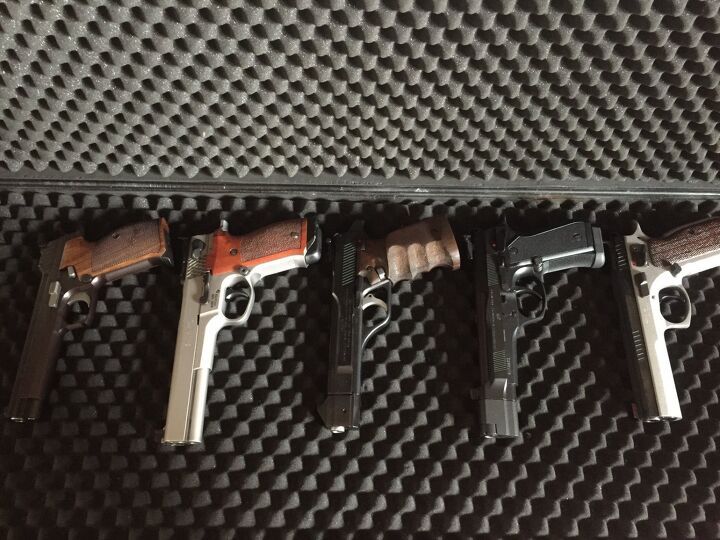
Group picture of bac1023’s entries into the test
The Smiths
After the age of the service revolver but before the rise of the Glock, the most common police sidearm were three generations of Smith & Wesson semiautomatic pistols. The pinnacles of these pistols were produced by the Smith & Wesson Performance Center, which was established by Paul Liebenberg and others at S&W. The original Performance Center did not just customize pistols built on the factory line but rather built its own guns much like a modern semi-custom 1911 shop. These firearms were hand built with painstaking care to the highest levels of quality and precision.
The precursor to these Performance Center pistols was the old Smith & Wesson Model 52, a .38 Special Midrange Wadcutter bullseye pistol. The 52 was succeeded by the Performance Center built single stack S&W 952 9mm and S&W 845 .45ACP.
S&W 5906 PPC9 6”

S&W 5906 PPC9 6″
The pistols we tested were among the most accurate ever produced by the Smith & Wesson Performance Center. The first is a 5906 PPC9 6”. This was a single action only double stack 9mm similar to the single stack 952 but built specifically for PPC police competition. The PPC9 was built in both 5” barrel and the much more scarce 6” barrel models. Like the rest of the Performance Center pistols, the PPC9 was hand fitted with a Briley spherical bushing to ensure tight barrel to slide fit and had its slide hand lapped to the frame and blended. Both the 952 and PPC9 were well known for their accuracy and were used in bullseye and PPC competition.
S&W 3566 Limited 5”
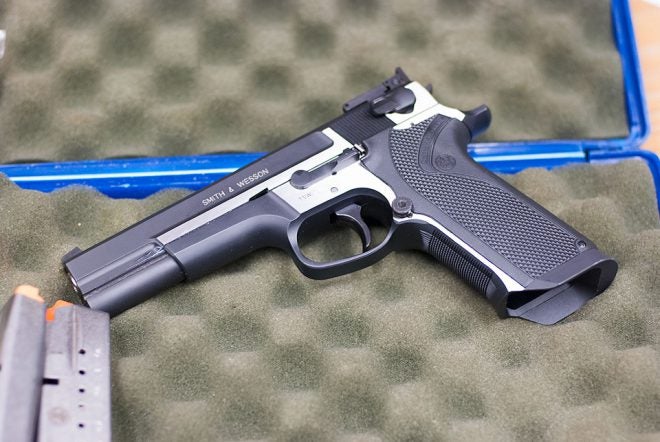
S&W 3566 Limited
The second pistol is the 3566 Limited 5”. This pistol was based on the single action only 5906 PPC9 5”, but, instead of 9mm, this was chambered in .356TSW. TSW stood for Team Smith & Wesson and later Tactical Smith & Wesson. This unusual caliber was a 9×21.5mm round similar to an extended 9mm but designed to make 9mm major classification in IPSC/USPSA type practical shooting competitions. .
The brass is tapered like 9mm not straight walled like .38 Super. Since it is no longer available, brass can be made by cutting down 9×23 brass. Corbon .356TSW JHP drove 124 grain bullets at 1450 fps. This compares favorably with Speer Gold Dot .357 Magnum which drives 125 grains at 1450 fps. This is hotter than the Gold Dot .357 Sig at 125 grains at 1350 and also hotter than the Gold Dot 124 grain 9mm +P loading at 1220 fps. This is less energy, however, than the .357 Magnum loading of Buffalo Bore which can drive 125 grain bullets at 1700 fps for a 6″ barrel and 1600 fps with a 4″.
The 3566 came in three models. In addition to this single action only 5” model based on the PPC9, there were two other models. One was a DA/SA compact with a 3.5” barrel, and the other one was the rare stocking dealer model with a DA/SA action and 4.25” barrel.
This particular example came with both the original .356TSW barrel and a Performance Center fitted 9mm barrel. For purposes of this test we used the 9mm barrel.
Both S&W pistols have outstanding single stage single action triggers with almost no take up and a clean break with an incredibly short reset. The 3566 has a trigger pull weight of 2.65 lbs. on the Lyman trigger gauge.
The Sigs
Produced by SIG {Schweizerische Industrie Gesellschaft) and its successors SIG Arms and SAN Swiss Arms AG in Neuhausen am Rheinfall, Switzerland, the legendary P210 is a match accurate service pistol. Design of the P210 began in 1937 based on the Charles Petter Modèle 1935A pistol. The end result was a single action only single stack pistol possessing extraordinary abilities. The pistol entered service in 1949 with the Swiss army and saw service up through the conflict in Afghanistan with the Danish army. Numerous variants of the P210 were produced for service and target use, and P210 pistols were produced in 9mm, .30 Luger and .22lr. All variants were extremely accurate. The pistols came with 50 meter test targets typically showing a 5 to 10 shot group of 5 cm or less.
As bac1023 has always believed, no pistol in history combines outstanding accuracy, superb build quality, incredible durability, non-stop reliability, and a storied military pedigree like the Sig P210. There are pistols that can match or even exceed it in a couple categories, but nothing beats it when everything is combined. This pistol stands alone at the top. It’s really that good and undoubtedly one of the finest pistols in the world.
Sig Arms P210-5 Heavy Frame tuned by Waffen Oschatz
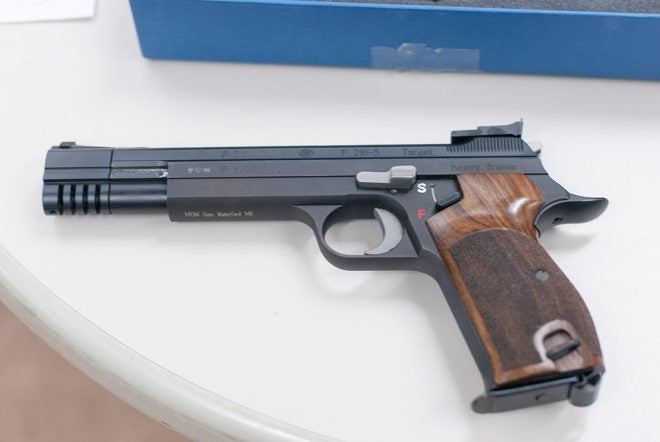
Sig Arms P210-5 Heavy Frame (Waffen Oschatz)
The particular example we tested is a later model Swiss made P210-5 Heavy Frame extended barrel target pistol variant.
It is a late production P210-5 Heavy Frame made by Sig Arms in Neuhausen Switzerland in 1993 before they became SAN. The P210-5 was a sport/target model with a sport trigger, adjustable sights, and extended barrel. This was one of the earlier CNC milled models but likely has the later cast hammer action housings with MIM internals. It was purchased by its German owner in Switzerland and personally imported to Germany. In Germany, it was modified by the tuning house Waffen Oschatz with a Karl Nill screw-in beavertail to prevent hammer bite and Karl Nill grips. Oschatz also removed the standard extended barrel sight of the P210-5 and replaced it with their own barrel weight. Finally the trigger and action were tuned.
The finish is excellent but utilitarian. The frame is a dull matte; whereas, the slide is a sort of satin finish. The fit is amazing. It is incredibly smooth to rack. It feels like the slide is skating on ice but there is no play at all. It feels frictionless but not loose.
The aftermarket Karl Nill beavertail eliminates the issue of hammer bite endemic to the P210. The Nill grip has a nice swell to it that fits the hand well and is extremely comfortable. While the grip and feel are excellent, the controls leave much to be desired. The small safety is hard to reach and is quite stiff making it hard to use with the primary hand thumb. It also leaves the classic safety scratch that all Swiss P210s have. The slide release is well forward and also hard to reach so you must either sling shot the slide or use your weak hand to hit the release.
The trigger is great. The first stage of the trigger is very light and super smooth and the break crisp, clean and light without noticeable over-travel. On a Lyman scale the trigger is 3.0 lbs.
This P210 came with a test target showing a center to center extreme spread of 1.78” for 6 shots at 50 meters.
Sig Sauer P210 Legend Target

Sig Sauer P210 Legend Target
Long after the SAN Swiss Arms P210 was discontinued, SIG Sauer revived the P210 design as the P210 Legend series. The P210 Legend was produced in Eckernförde, Germany by SIG Sauer, successor to the partnership between Sig and J.P. Sauer und Sohn. The Legend was based on the late P210-8 Swiss variant and incorporated a side magazine release rather than the usual heel release of the older P210. The Legend also incorporated a beavertail to prevent the notorious hammer bite of the original. These Legend pistols were only tested off a bench at 25 meters rather than the original 50 meter machine rest test of their progenitors.
The Legend has a carbon steel frame of the heavy type. The slide is machined from solid billet carbon steel, like the original. The finish is outstanding on the Legends. It’s a Nitron coating that is very even and beautiful in appearance and is also supposed to be very durable. While it’s hard to beat the looks of the polished blue finish on the early P210-1 models, the Nitron finish is certainly a big improvement in appearance over the dull matte finish that most of the Swiss models wore. It’s very even and very smooth and just shiny enough to give the gun a classy appearance, without overdoing it.
Speaking of appearance, the P210 Legend Target is a masterpiece of elegance. From the heavy frame, to the nicely shaped trigger guard, to the beautiful palm swell Nill grips, to the fine checkering, to the awesome finish, to the timeless beauty of the P210 design itself, it has a really sculpted look to it. This is an absolutely gorgeous firearm. Just the rear target sight itself is so extremely well blended into the top of the slide that it adds to the beauty of the pistol. The Swiss models with the target sights were basically just staked on there and looked pretty bad in comparison. Another aspect that looks pleasing to the eye is the rear cocking serrations. They look better than the originals and, more importantly, are wider and easier to get a grip on to rack the slide. Strangely enough, Sig decided to omit the serrations on the top of the slide from the ejection port to the front sight that the Swiss models have.
Ergonomics of this pistol are incredibly good. First are the palm swell grips. They just simply feel great and, coupled with the new beavertail, make gripping the Legend Target incredibly comfortable. Another notable is the cut out radius under the trigger guard. Like it does on a 1911, this allows your hand to grip higher on the gun. The grips, beavertail, and trigger guard complement each other so well. Not only do they look beautiful, but they work in unison to substantially improve the ergonomics of this P210 compared to the older Swiss models.
Despite the ergonomic improvements, many P210 collectors believe that the Swiss-made P210s are of higher quality than the German-made P210 Legends. Also a result, we also included a Sig Sauer P210 Legend Target in our test in order to help settle the debate about Swiss versus German P210s.
Sig Hämmerli P240
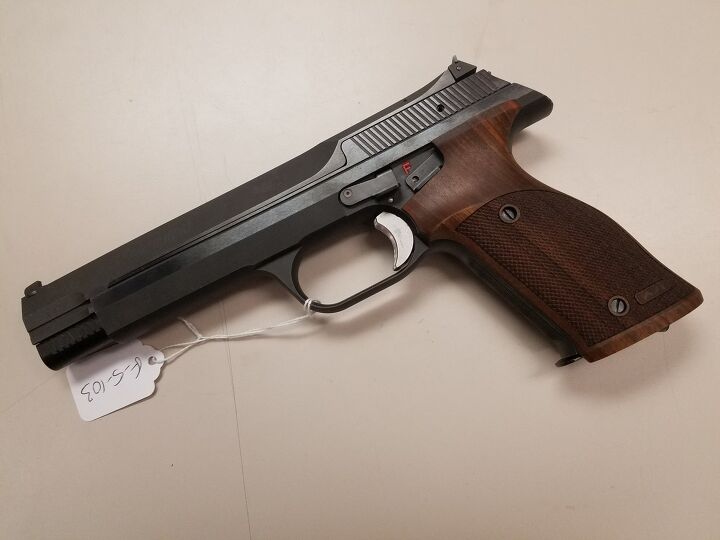
Sig Hämmerli P240 .32 S&W Long
The Sig P240 began as an attempt to make a 38 Special Midrange Wadcutter variant of the P210. This effort expanded out into .32 and .22 variants as well. The P240 parts were made by Sig Arms in Neuhausen, Switzerland, and the barrel was made and assembly and fitting were done by the Hämmerli subsidiary of Sig Arms in Tiengen, Switzerland. The .38 Special model had a reputation for bulging its thin walled barrel with hot .38 Special ammunition. This was not a problem for the .32 S&W Long and .22lr variants. The P240 came with test targets shot at 25 meters typically showing all shots touching. The .38 came with a full size test target while the .32 and .22 came with medallions showing the test target.
Although based on the P210, the P240 do not lock up at the barrel lugs for the .38 Special variant and instead lock up at the ejection port. The .32 and .22 variants have fixed barrels.
The trigger of the P240 is even better than the excellent trigger on either P210, and the trigger pull weight is approximately 2 lbs.
Sig Sauer P226S X-Five Enhanced Classic
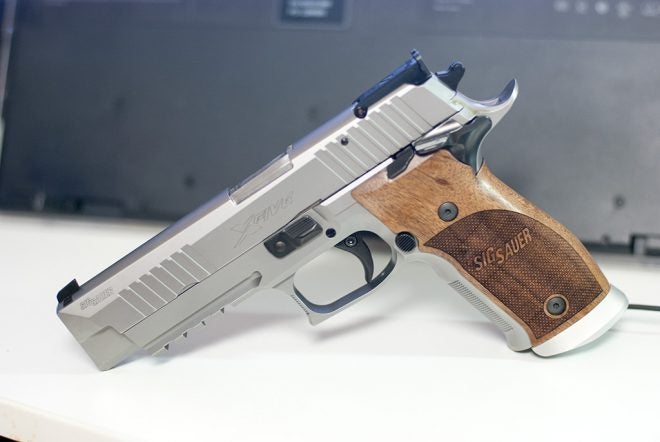
Sig Sauer X-Five Classic 9mm
The Swiss eventually replaced their Sig Arms P210 as their service pistol with a new cheaper design the SIG Sauer P75 also known as the P220. The P220 was a single stack pistol which spawned the double stack 9mm P226. The P220 and P226 are still in production and in service around the world. Sig Sauer also produced target variants of the P226 and P220. Sig produced a Sport Series of competition pistols for a short period of time which were succeeded by the X Series. Both the Sport and X Series were meticulously built heavy variants of the P226 for competition use. The X Series were succeeded by the second generation X Series. This second generation X Enhanced line introduced modularity to the X pistol design allowing one pistol to be used for multiple purposes.
The X-Series we tested here is the Sig Sauer P226S X-Five Enhanced Classic. Fit and finish are fantastic, and the pistol feels precision machined like scientific instrumentation. The grips also feel fantastic. The pistol is very heavy to begin with, and with the added X Weight module, the X Mount and the Aimpoint T-2 sight, it is exceptionally heavy. This weight makes 9mm feel like .22lr.
Out of the box, the trigger was set up poorly. It had tons of over-travel and was set at the higher end of the weight scale. However, the single action trigger pull is fully adjustable for trigger weight, over-travel and trigger position/reach. It is also adjustable for pre-travel although the adjustment is undocumented in the manual.
Weight can be adjusted from 2.25 to 3.6 lbs., and we adjusted the trigger to 2.6 lbs. on the Lyman pull gauge. The over-travel stop can be adjusted in a range of about 2.3 mm. Almost all the over-travel was dialed out except for a tiny bit deliberately left in. Trigger position can be adjusted back and forth about 10mm. The trigger position was pulled back about 6 to 7 mm or so. As set up now, the trigger has about 3 to 4 mm of take up and a crisp break of less than 1 mm at 2.6 lbs. and a reset of 2 mm.
This X-Five came with a test target of five shots at 25 meters with four shots going into a group that is 0.39” center to center and the fifth flyer making the group approximately 1” center to center.
CZ
Other than the 1911, probably no other semiautomatic pistol has been cloned more than the venerable CZ75. The CZ has been copied by Tanfoglio, Sphinx, IMI Jericho/Baby Eagle, Canik, and Sarsilmaz among others. While the CZ hasn’t found general acceptance as a service pistol in the U.S., the CZ75 and its variants and clones have found a home among competition shooters in the action pistol disciplines.
CZ75 Tactical Sport
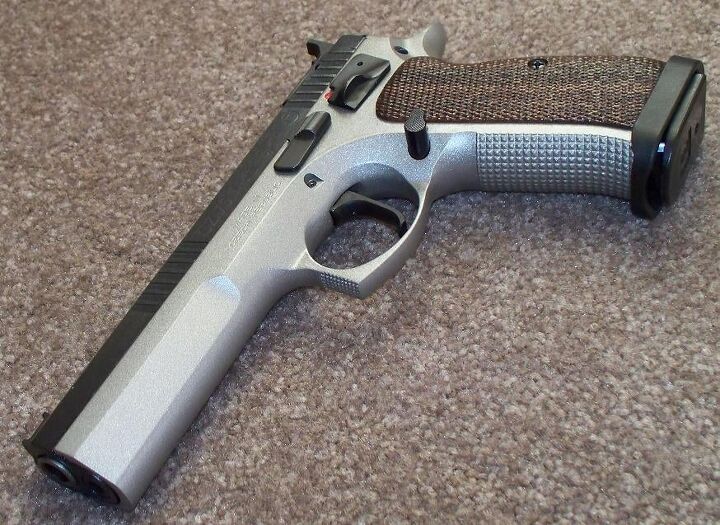
CZ 75 Tactical Sport 9mm
The CZ Tactical Sport has been around for 10 years and is extremely popular in Europe for competitive shooting. It was designed for IPSC. More specifically, it’s a purpose built single action only competition pistol and is weighted to make rapid fire easy. It’s based on the standard CZ75 design with the slide riding inside the frame. True to its intended use, the Tactical Sport comes standard with a large magwell, checkering on the front and back strap, an extended and oversize mag release, and a hook style rear sight. The frame is enlarged and the magazines are also wider and longer. It weighs 45.2oz empty, which is a full 9oz heavier than the all steel CZ 75B.
The Tactical Sport also lacks a firing pin safety, and the single action trigger is exceptionally light. The trigger is almost as good as the CZ75 Champion; although being plastic, it doesn’t feel quite as crisp.
Available calibers are 9mm and 40S&W. The Tactical Sport is a very high capacity pistol, holding 20+1 rounds of 9mm.
Other than the Glock 17L, the Tactical Sport is the least expensive pistol in the test.
The Italians
Pardini GT45-II 5” 9mm
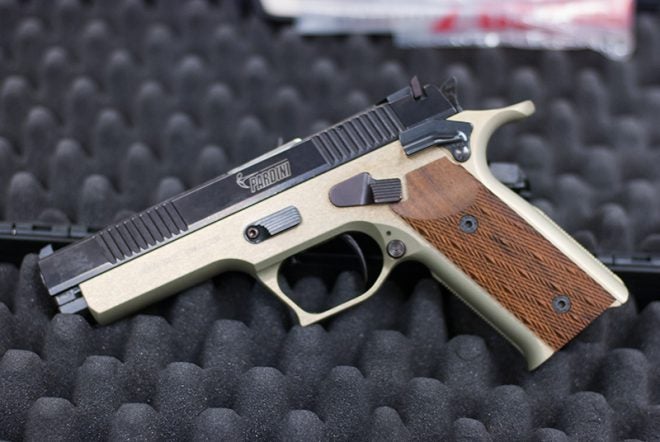
Pardini GT45-II 9mm
Pardini was founded by Giampiero Pardini, an Italian competition shooter, who began designing his own competition pistols in the 1970s. Pardini is best known for his Olympic rimfire target pistols, and the firing line at any international rimfire pistol competition is likely to feature many Pardinis.
The Pardini GT series was introduced back in the late 1990‘s/early 2000‘s for the bullseye and action shooting disciplines and is still being built at the time of this writing. The GT was built in 9mm, .40S&W and .45ACP versions. The 45ACP version has a slightly larger frame and can be converted between all 3 calibers. This particular version is a 9mm built on the larger GT45 frame.
The Pardini GT is a competition-bred pistol in every way. The severely swept back grip angle keeps the bore axis extremely low. The low profile adjustable sights complement the grip angle perfectly. The beavertail allows a high grip and, coupled with the trigger reach, gives the shooter outstanding ergonomics despite the grip being big and blocky like a 2×4.
The slide is hard to grip. Since it rides in the frame much like a Sig P210 or CZ75, there is not as much to grab. Yuns keeps bumping his hand on the huge safety every time he racks the slide so he uses the front serrations to rack it. Racking the slide feels incredibly smooth. Bac1023 attests that the Pardini GT is the smoothest pistol in his entire collection. The slide to frame fit is tight, yet feels as though it’s sliding on ball bearings.
The frame is aluminum but thick and heavy duty. Everything about the GT is overbuilt, including the thick, heavy barrel.
The trigger is mind blowing. The pull is fully adjustable. Both length and weight of the second stage can be adjusted. Over-travel can also be adjusted. There are also adjustments for overall trigger travel and sear engagement. As adjusted, the second stage break has basically no movement. The reset is a bit longer than a 1911 or a 3rd generation S&W. The pull weight is set to 2.2 lbs. (with 1 lb. 15 oz. take up and 4 oz. break). Trigger travel to break after take up is less than 0.3mm, and reset is 3mm.
Beretta 92 Combat
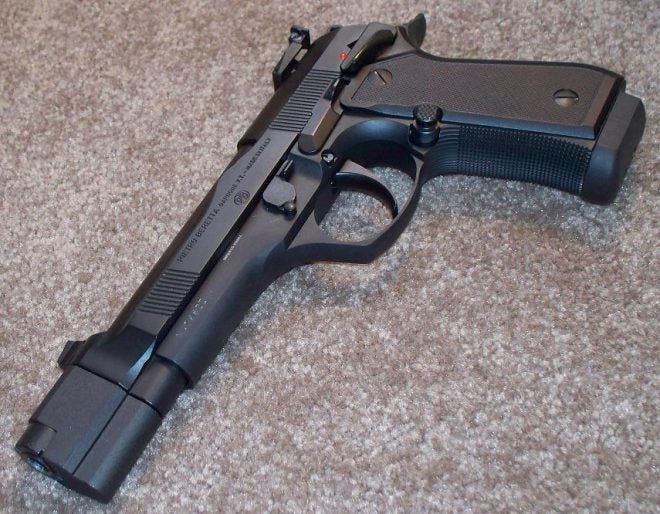
Beretta 92 Combat
The 92 and 96 Combat series were Beretta’s single action IPSC pistols. They debuted about 15 years ago and were produced for just a short time. They were built for speed and accuracy and came with many competition features such as front slide serrations, coarse checkering on the front and back strap, large adjustable sights, a large mag release button, and magazines with large rubber bases for easy control and protection from dropping. The Combat also features a finely tuned single action only trigger and an accurizing barrel bushing around the end of the extended 150mm barrel. The barrel weight at the muzzle helps improve overall balance and handling. The large, frame mounted ambidextrous safety is easy to reach and operate. The thin aluminum grips feature tacky texturing to further improve traction and control. The 92 Combat is surprisingly light since the frame is alloy rather than steel.
Very few Combat series Berettas were ever imported and the vast majority were 96 Combat models. The 92 Combat is especially rare. The Combat comes in a large case which includes two extra magazines, a 5.5” barrel, a special bushing wrench, and a cleaning brush. It also comes with a standard 92 owner’s manual and a special owner’s manual just for the Combat and Stock pistols.
Benelli MP3S .32S&W Long W.C.
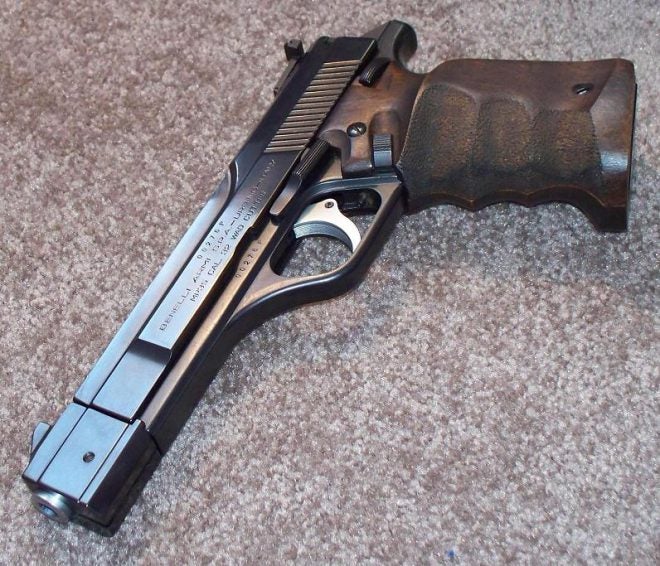
Benelli MP3S .32
Benelli is known best for their shotguns, but in the 80s, Benelli tried to enter the handgun market with a series of accurate traditional double action single stack pistols with excellent triggers. The B76 was the 9mm variant, but there were also other calibers available including the B77 and B80 in .32ACP and .30 Luger respectively. The 9mm and .30 Luger variants used a lever-delayed blowback system, which Benelli called “Inertia Lock”. The .32 and 9mm Ultra variants were of a straight blowback design. Unfortunately, it was the wrong pistol at the wrong time.
In addition to the regular models, there was also a sport variant with a DA/SA trigger, which featured an extended barrel and barrel weight. The 9mm version was called the B76 Sport.
The MP3S was the ultimate single action only version of the Benelli series with a single action only trigger and extended barrel and weight. The MP3S we tested is in the more common .32 S&W Long. Most of the MP3S were chambered in the bullseye-oriented .32 S&W Long Wadcutter, but they were also offered in 9mm. The 9mm MP3S was the rarest version of the Benelli pistols, and we are aware of only four in private ownership in the US including two 9mm versions owned by us.
The finish of the MP3S is upgraded over the standard B Series guns to a high polish lustrous blue, which is fitting for a handgun of such elegance and beauty. The MP3S features a 5.5” fixed barrel with a weight attached to the end for stability with a one handed grip and bullseye stance. The sights are big and fully adjustable and the trigger is light and crisp with very little initial take up. This is a large, all steel pistol, so it’s not light with an unloaded weight of 42oz.
Glock 17L 9mm (3rd Gen)
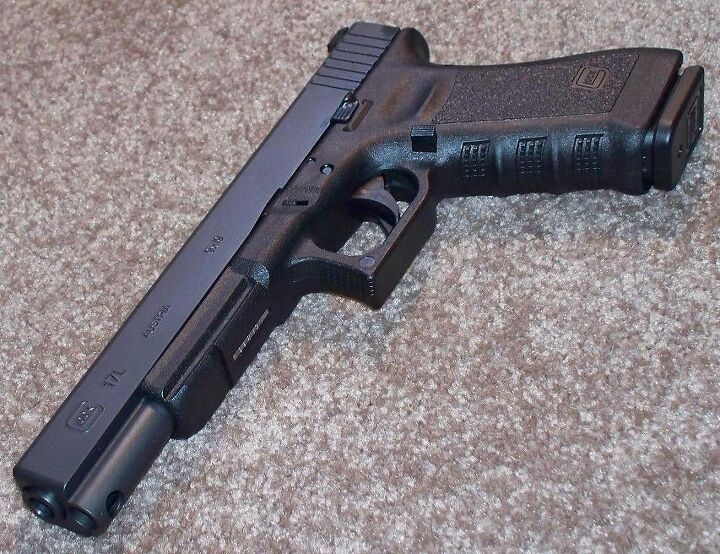
Glock 17L (3rd Gen)
We felt we needed a frame of reference so we decided to test a striker fired polymer pistol. We also wanted to keep the test fair so we chose a long slide competition version of the pistol. This is how we ended up testing the Glock 17L (3rd gen).
The G17L was the second model Glock introduced, and it has been around since 1988. These days, Glock doesn’t offer them as a regular item, but they are still built in batches from time to time. The G17L is the long slide competition version of the G17 and has a standard trigger weight of 4.5lbs, which is a pound lighter than the G17. The slide is slotted and relieved and the barrel is 6”. The earlier versions had ported barrels which is no longer the case today. Our G17L was test fired by Glock in January 2012.
Methodology
We did not sight in or shoot practice groups with the pistols. We also did not cherry pick any results. This data is all the results: good, bad and ugly. We did a quick function test at 35 feet with cheap ammunition at the beginning of the day, then shot for results and counted all the shots after the function test.
We tried our best to reduce the human factor in the test. Unfortunately, we did not have a Ransom Rest or the grip inserts that would have been needed for each pistol for a Ransom Rest. Instead we shot each pistol from standing with the bottom of our hands resting on sandbags or blocks placed on a bench for support. While this did reduce the human factor, we were still constrained by the quality of our eyesight and the quality of the sights.
We used the same ammunition for each pistol. We used Atlanta Arms 115 grain 9mm FMJ match ammunition developed for the Army Marksmanship Unit and Lapua 98 grain LWC match ammunition for the .32 S&W Long WC. The Atlanta Arms AMU ammunition is capable of 5 ten-shot groups at 50 yards with an average group size not to exceed 1.5 inches out of a test barrel fixture. The Lapua 98 grain is likewise known for its exceptional accuracy.
The targets were rifle zeroing targets consisting of a large center diamond surrounded by four diamonds around the corners marked with a grid of ½” squares.
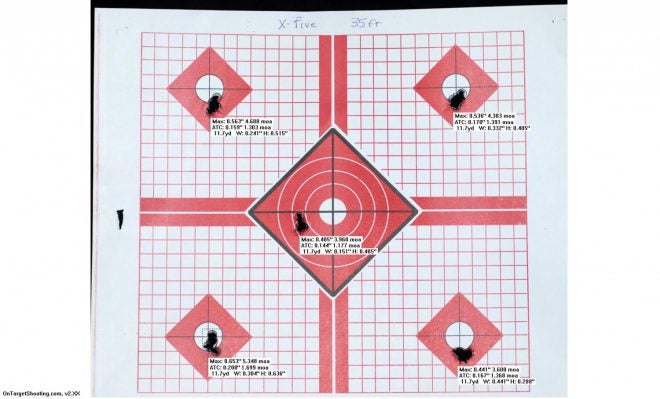
Target used for the X-Five 35 foot test
We began at 35 feet (11.7 yards) with one paper target for each pistol shooting a 5 shot group at each of the 5 diamonds starting with the upper left and continuing clockwise and finishing with the center diamond. This produced five 5-shot groups at 35 feet for each pistol.
We then moved the target stands to 25 yards. Since we did not zero the sights or check alignment for the pistols we started with the large center diamond and shot a 5-round group followed by two additional 5-shot groups on the smaller diamonds. We shot three 25 yard 5-shot groups for each pistol rather than five so that the groups would not overlap. (We did shoot five groups at 25 yards for the X-Five and CZ since there was no risk of overlap there.)
While ideally we would have each shot each pistol, we simply did not have the time so each of us shot half the pistols with the exception of the Glock 17L which we both shot as a reference. The conditions varied from humid heat to rain showers during our seven hours of shooting and it became a human endurance test as much as a pistol accuracy test.
We know that these results are not statistically rigorous. To improve the results, we should have each shot three to five 10-shot groups at each distance with each pistol. Given the time and physical constraints including our inability to be consistent during hours of shooting, we had to compromise on our methodology. We did not throw out any groups or flyers and have provided all our raw data in an attempt to allow the reader to look at and analyze the data themselves and draw their own conclusions.
Reliability
We were pleased to report that we had no mechanical malfunctions. Closely-fitted target pistols have a reputation for being less reliable than service pistols, but in this small test, we encountered no FTF, FTE or other feed or cycling issues. The only issues we had were sight related. The set screw on the front sight of the Pardini worked its way loose which caused the front sight to fall off ending the Pardini test prematurely with not all the 25 yards groups completed. The Benelli sights were adjusted off the paper and needed to be readjusted for the 35 feet groups.
The Results
We were surprised by the .32 caliber results. We really expected the .32s to run away with this test as the ringers of the group. Typical Sig Hämmerli P240 test medallions show groups well within an inch at 25 meters typically with all rounds touching. .32S&W Long target pistols are exceptionally accurate at 25 meters or less. Despite the inherent mechanical accuracy and low recoil of the 32 target pistols, we found it challenging to shoot them to their potential. As to why, we are uncertain. Both the Benelli and the Sig Hämmerli have incredible triggers and ergonomics. In the case of the Benelli, the main problem was the sights which were set up wrong. The Sig Hämmerli P240 may just require more trigger time and perhaps more focus on follow through.
Sig Hämmerli P240
| Category | Size (Inches) | Rank |
| Smallest 25 Yard Group | 1.30 | 3 |
| Average 25 Yard Group | 2.43 | 6 |
| Average 25 Yard Group (Excluding Worst) | 1.80 | 3 |
| Smallest 35 Foot Group | 0.91 | 9 |
| Average 35 Foot Group | 1.34 | 10 |
| Average 35 Foot Group (Excluding Worst) | 1.13 | 8 |
The P240 had an excellent overall third best 25 yard group of 1.30 inches but a mediocre best 35 foot group of 0.91. Our lack of ability in getting consistent group sizes meant that the decent best groups were pulled down to mediocre average group sizes of 2.43 inches at 25 yards and 1.34 inches at 35 feet.
Benelli MP3S
| Category | Size (Inches) | Rank |
| Smallest 25 Yard Group | 2.07 | 9 |
| Average 25 Yard Group | 2.43 | 7 |
| Average 25 Yard Group (Excluding Worst) | 2.32 | 8 |
| Smallest 35 Foot Group | 0.79 | 6 |
| Average 35 Foot Group | 1.00 | 4 |
| Average 35 Foot Group (Excluding Worst) | 0.91 | 4 |
The Benelli fared poorly because of misaligned sights. We had to adjust the sights part way through the test so we could only get four groups at 35 feet and the groups reflected the issue of the sights.
The best 25 yard group was 2.07 inches and average 25 yard group was 2.43 inches. The best 35 foot group was 0.79 inches and average 35 foot group was 1.00 inches.
S&W 3566
| Category | Size (Inches) | Rank |
| Smallest 25 Yard Group | 1.38 | 4 |
| Average 25 Yard Group | 2.22 | 4 |
| Average 25 Yard Group (Excluding Worst) | 1.96 | 5 |
| Smallest 35 Foot Group | 0.87 | 7 |
| Average 35 Foot Group | 1.07 | 5 |
| Average 35 Foot Group (Excluding Worst) | 1.02 | 5 |
The 3566 had poor 35 foot results but adequate 25 yard results. The best 25 yard group was a good 1.38 inches and the average 25 yard group was 2.22 inches. The best 35 foot group was a 0.87 inches and the average 35 foot group was 1.07 inches.
Yuns believes the very light single stage trigger actually caused him to have some flyers.
S&W 5906 PPC9 6″
| Category | Size (Inches) | Rank |
| Smallest 25 Yard Group | 1.63 | 4 |
| Average 25 Yard Group | 1.92 | 2 |
| Average 25 Yard Group (Excluding Worst) | 1.72 | 2 |
| Smallest 35 Foot Group | 0.42 | 1 |
| Average 35 Foot Group | 0.89 | 3 |
| Average 35 Foot Group (Excluding Worst) | 0.70 | 2 |
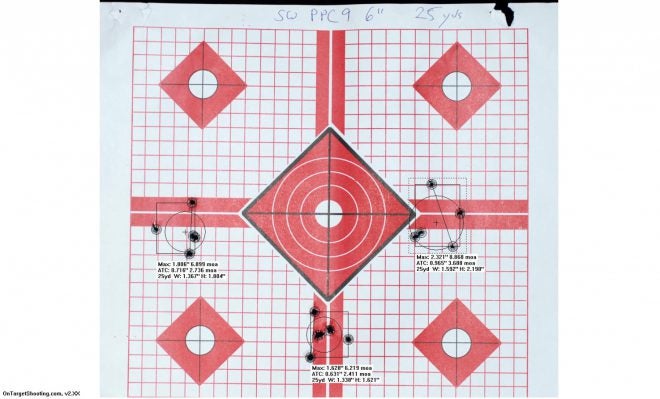
By virtue of consistency the PPC9 came in second place in our accuracy test. It did not have the overall second smallest 25 yard group at 1.63 inches but it did have the overall second smallest average 25 yard group at 1.92 inches.
In addition the PPC9 has the overall smallest 35 foot group of 0.42 inches and the overall third smallest average group size at 35 feet of 0.89 inches. The 35 foot average was thrown off by a single bad group of 1.6 inches.
If the PPC9 had a red dot optic, it may have won the competition.
Sig Arms P210-5 Heavy Frame tuned by Waffen Oschatz
| Category | Size (Inches) | Rank |
| Smallest 25 Yard Group | 1.62 | 5 |
| Average 25 Yard Group | 3.12 | 9 |
| Average 25 Yard Group (Excluding Worst) | 2.03 | 6 |
| Smallest 35 Foot Group | 0.79 | 5 |
| Average 35 Foot Group | 1.08 | 6 |
| Average 35 Foot Group (Excluding Worst) | 1.03 | 6 |
We were disappointed by the performance of the P210-5. Based on the test target, we know it is capable of groups less than 2 inches at 50 meters. This alone should have made the P210-5 one of the front runners in this group test. But this mechanical accuracy was let down by iron sights that were less than ideal. Yuns found his eyes getting tired quickly and as a result the group sizes swung wildly.
The best 25 yard group was an acceptable 1.62 inches but the average 25 yard group size was a miserable 3.12 inches because of a terrible group of 5.28 inches.
The best 35 foot group was 0.79 inches and the average was 1.08 inches.
This is a pistol that would have been clearly aided by a red dot sight and may have ended up in the top three if we had used an optic.
Sig Sauer P210 Legend Target
| Category | Size (Inches) | Rank |
| Smallest 25 Yard Group | 1.83 | 8 |
| Average 25 Yard Group | 2.02 | 3 |
| Average 25 Yard Group (Excluding Worst) | 1.85 | 4 |
| Smallest 35 Foot Group | 1.00 | 10 |
| Average 35 Foot Group | 1.25 | 8 |
| Average 35 Foot Group (Excluding Worst) | 1.17 | 10 |
The P210 Legend was very consistent. The best 25 yard group was a poor 1.83 inches but the average 25 yard group was a third best 2.02 inches.
The best 35 foot group was 1.00 inches and the average 35 foot group was 1.25 inches.
These were solid but not exceptional results from the German P210 and it appears that the Swiss P210 might have a slight edge on it based on best groups.
Sig Sauer P226S X-Five Enhanced Classic
| Category | Size (Inches) | Rank |
| Smallest 25 Yard Group | 0.89 | 1 |
| Average 25 Yard Group | 1.31 | 1 |
| Average 25 Yard Group (Excluding Worst) | 1.23 | 1 |
| Smallest 35 Foot Group | 0.44 | 2 |
| Average 35 Foot Group | 0.54 | 1 |
| Average 35 Foot Group (Excluding Worst) | 0.51 | 1 |
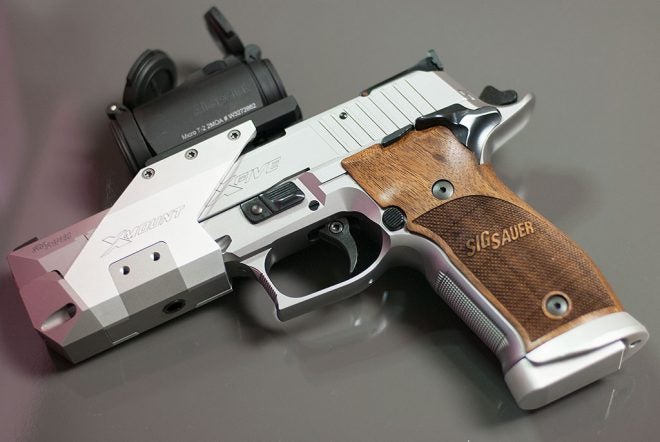
The X-Five had the unfair advantage of the Aimpoint T-2 red dot sight. This was reflected in the sheer consistency of group after group. We did not have the broader swings in group size at 25 yards that we had with other pistols as we settled into each new set of iron sights.
The X-Five achieved stunning accuracy. The smallest 5-shot group at 25 yards was 0.89 inches and the average 25 yard group (average of five groups) was a best overall 1.31 inches. These were both the smallest overall. The X5 also achieved the overall second smallest 35 foot 5 shot group of 0.44 inches and smallest 35 foot average group of 0.54 inches.

Even the worst groups were excellent. The worst 35 foot group was 0.65 inches and the worst 25 yard group was 1.63 inches.
The X-Five was the clear winner coming in first in nearly every metric, but we should have either equipped the other pistols with red dot sights or removed the red dot sights from the X-Five to keep the competition fair.
CZ 75 Tactical Sport
| Category | Size (Inches) | Rank |
| Smallest 25 Yard Group | 1.03 | 2 |
| Average 25 Yard Group | 2.30 | 5 |
| Average 25 Yard Group (Excluding Worst) | 2.11 | 7 |
| Smallest 35 Foot Group | 0.72 | 4 |
| Average 35 Foot Group | 0.89 | 2 |
| Average 35 Foot Group (Excluding Worst) | 0.84 | 3 |
The CZ Tactical Sport was the clear price to performance ratio winner.
It had a second best 25 yard group of 1.03 inches but was let down by a 2.30 inch average 25 yard group. The other four groups ranged from 2 to 3 inches.
It also had a 35 foot group of 0.72 inches and the second best average 35 foot group of 0.89 inches.
Although it did not outright win, the CZ kept up with pistols costing many times as much.
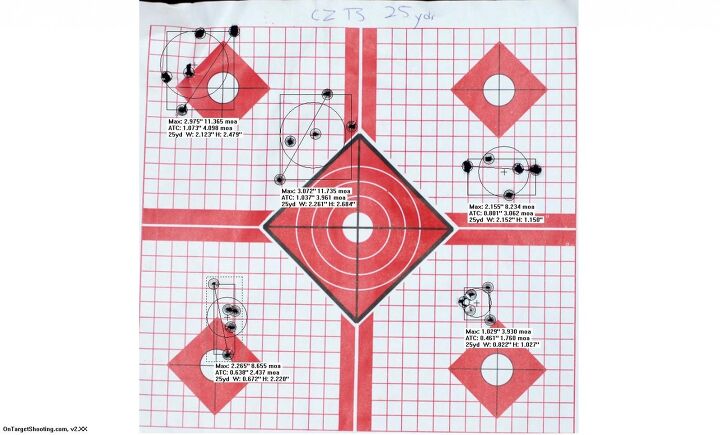
Pardini GT45-II 9mm
| Category | Size (Inches) | Rank |
| Smallest 25 Yard Group | 1.80 | 7 |
| Average 25 Yard Group | N/A | N/A |
| Average 25 Yard Group (Excluding Worst) | N/A | N/A |
| Smallest 35 Foot Group | 0.91 | 8 |
| Average 35 Foot Group | 1.30 | 9 |
| Average 35 Foot Group (Excluding Worst) | 1.13 | 9 |
The loss of the front sight ended testing early and although we had five 35 foot groups, we only got a single 25 yard group. The single 25 yard group was 1.80 inches so its rank was ignored for average group size purposes.
The best 35 foot group was 0.91 inches and the average 35 foot group was 1.30 inches. Because of our issues with the sight, it is difficult to draw any clear conclusions from the test.
Beretta 92 Combat
| Category | Size (Inches) | Rank |
| Smallest 25 Yard Group | 3.42 | 11 |
| Average 25 Yard Group | 4.01 | 10 |
| Average 25 Yard Group (Excluding Worst) | 3.53 | 10 |
| Smallest 35 Foot Group | 1.18 | 11 |
| Average 35 Foot Group | 1.68 | 11 |
| Average 35 Foot Group (Excluding Worst) | 1.57 | 11 |
The Beretta was a grave disappointment. With the extended barrel, special bushing and outstanding single action only trigger, we had high hopes for this pistol.
The best 25 yard group of 3.42 inches was by far the worst of the test. The Beretta came in last in every category.
The Beretta was by far the least accurate pistol tested. We are not quite sure what happened here and we will revisit the Beretta in the future after checking it for mechanical or other issues which may have caused problems.
Glock 17L 3rd Gen
| Category | Size (Inches) | Rank |
| Smallest 25 Yard Group | 2.16 | 10 |
| Average 25 Yard Group | 2.68 | 8 |
| Average 25 Yard Group (Excluding Worst) | 2.32 | 9 |
| Smallest 35 Foot Group | 0.63 | 3 |
| Average 35 Foot Group | 1.15 | 7 |
| Average 35 Foot Group (Excluding Worst) | 1..07 | 7 |
The Glock 17L was the one pistol that we both shot. We both had good results at 35 feet. Yuns achieved the best 35 foot group of 0.63 inches which was the third best overall and bac1023 achieved an average 35 foot group of 1.15 inches.
However, the story changed at 25 yards. Yuns had mediocre but consistent 25 yard results but bac1023 had inexplicably poor results at 25 yards. Yuns had a best group of 2.16 inches and an average of 2.68 inches. However, bac1023 had a best group of 2.77 inches and an average group of 5.71 inches. We suspect that the transition from ultra-light single action triggers to the Glock trigger at the end of the day may have thrown off bac1023.
Conclusions
Based on the best group sizes, nearly all of the pistols performed well. Nearly every single pistol was capable of a group of less than 2 inches at 25 yards and less than 1 inch at 35 feet (11.7 yards). Despite the good performance, there was a clear stand out winner, the X-Five.
The X-Five shot the overall smallest group at 25 yards as well as the overall smallest average group at 25 yards and at 35 feet. This consistency, however, was likely driven by the unfair advantage of the Aimpoint T-2 red dot sight. Other pistols had excellent groups but could not get the consistency. This variability in the other pistol groups seemed highly affected by the type of iron sights particularly those used in the older pistols. Regardless of the unfair advantage, the X-Five turned in tiny group after tiny group including that 25 yard group of well under an inch.
The runner up was the S&W PPC9 6 inch. With that long sight radius, that hand built Performance Center fit, Briley bushing and excellent single stage trigger, the PPC9 excelled at accuracy. Its consistency nearly won the day. It may have been a closer race if we had mounted a red dot to the PPC9 instead of the irons.
The performance bargain was the CZ75 Tactical Sport. The TS ran competitively with pistols costing many multiples of its price and even beat many pistols costing far more. The sight radius, light trigger and weight make this a joy to shoot. For the shooter on a budget, the TS is an outstanding choice.
As noted earlier, in a better test, we would have shot three to five 10-shot groups at each range with each pistol for more statistically significant results. We could not do so due to time, fatigue and other human constraints. The day after our group test, Yuns shot a single group at 25 yards with each of the Sig Arms P210-5 HF and the Sig Sauer X-Five at an indoor range for an additional reference. An 8-shot group with the P210-5 was 2.13 inches and a 10-shot group with the X-Five was 1.81 inches.
We began this test by trying to ascertain the most accurate pistols in this group test of high quality target pistols. We did our best to remove the human factor by shooting over support. Despite our best efforts, we ended up constrained by a very human factor: our vision and our ability to see each respective set of sights. Running this test outdoors over the course of 7 hours with heat and intense humidity giving way to rain showers made this as much a test of human endurance as mechanical accuracy. We hope this test was in some way helpful, but we stress that all these results should be taken with a grain of salt. This is a sample set of one of each pistol with one type of ammunition and one set of shooters. Your mileage may vary.
We have many more handguns and much more testing to do and publish. Next on the agenda for us are more group tests including a 1911 group test as well as a CZ and CZ clone group test.
We hoped you enjoyed reading our work as much as we enjoyed the testing itself. Stay tuned for much more to come…
Best 25 Yard Groups
| Sig Sauer X-Five Classic with Aimpoint T-2 | 0.893 |
| CZ 75 Tactical Sport | 1.029 |
| Sig Hämmerli P240 | 1.299 |
| S&W 3566 | 1.381 |
| Sig Arms P210-5 HF | 1.622 |
| S&W 5906 PPC9 6″ | 1.628 |
| Pardini GT45-II | 1.796 |
| Sig Sauer P210 Legend Target | 1.829 |
| Benelli MP3S | 2.07 |
| Glock 17L Gen 3 | 2.155 |
| Glock 17L Gen 3 | 2.77 |
| Beretta 92 Combat | 3.422 |
Best 35 Foot Groups
| S&W 5906 PPC9 6″ | 0.421 |
| Sig Sauer X-Five Classic with Aimpoint T-2 | 0.441 |
| Glock 17L Gen 3 | 0.63 |
| CZ 75 Tactical Sport | 0.719 |
| Sig Arms P210-5 HF | 0.789 |
| Benelli MP3S | 0.79 |
| S&W 3566 | 0.866 |
| Glock 17L Gen 3 | 0.88 |
| Pardini GT45-II | 0.906 |
| Sig Hämmerli P240 | 0.914 |
| Sig Sauer P210 Legend Target | 1.002 |
| Beretta 92 Combat | 1.181 |
Average 25 Yard Groups
| Sig Sauer X-Five Classic with Aimpoint T-2 | 1.3092 |
| Pardini GT45-II | 1.796 |
| S&W 5906 PPC9 6″ | 1.918333 |
| Sig Sauer P210 Legend Target | 2.018 |
| S&W 3566 | 2.222667 |
| CZ 75 Tactical Sport | 2.2992 |
| Sig Hämmerli P240 | 2.429 |
| Benelli MP3S | 2.429333 |
| Glock 17L Gen 3 | 2.681667 |
| Sig Arms P210-5 HF | 3.116 |
| Beretta 92 Combat | 4.01 |
| Glock 17L Gen 3 | 5.708667 |
Average 35 Foot Groups
| Sig Sauer X-Five Classic with Aimpoint T-2 | 0.5356 |
| CZ 75 Tactical Sport | 0.8888 |
| S&W 5906 PPC9 6″ | 0.8934 |
| Benelli MP3S | 1.00175 |
| S&W 3566 | 1.071 |
| Sig Arms P210-5 HF | 1.0768 |
| Glock 17L Gen 3 | 1.152 |
| Glock 17L Gen 3 | 1.2165 |
| Sig Sauer P210 Legend Target | 1.246 |
| Pardini GT45-II | 1.3022 |
| Sig Hämmerli P240 | 1.3352 |
| Beretta 92 Combat | 1.6774 |
Average 25 Yard Groups Minus Worst Group
| Sig Sauer X-Five Classic with Aimpoint T-2 | 1.2285 |
| S&W 5906 PPC9 6″ | 1.717 |
| Pardini GT45-II | 1.796 |
| Sig Hämmerli P240 | 1.7995 |
| Sig Sauer P210 Legend Target | 1.8535 |
| S&W 3566 | 1.958 |
| Sig Arms P210-5 HF | 2.034 |
| CZ 75 Tactical Sport | 2.106 |
| Benelli MP3S | 2.3185 |
| Glock 17L Gen 3 | 2.322 |
| Beretta 92 Combat | 3.5265 |
| Glock 17L Gen 3 | 4.2335 |
Average 35 Foot Groups Minus Worst Group
| Sig Sauer X-Five Classic with Aimpoint T-2 | 0.50625 |
| S&W 5906 PPC9 6″ | 0.70475 |
| CZ 75 Tactical Sport | 0.83575 |
| Benelli MP3S | 0.906667 |
| S&W 3566 | 1.02075 |
| Sig Arms P210-5 HF | 1.034 |
| Glock 17L Gen 3 | 1.070667 |
| Glock 17L Gen 3 | 1.071667 |
| Sig Hämmerli P240 | 1.12525 |
| Pardini GT45-II | 1.1335 |
| Sig Sauer P210 Legend Target | 1.16775 |
| Beretta 92 Combat | 1.57325 |
Raw Data
| Pistol | Distance | Group 1 | Group 2 | Group 3 | Group 4 | Group 5 |
| Sig Hämmerli P240 | 35 ft | 0.914 | 1.161 | 1.538 | 0.888 | 2.175 |
| Benelli MP3S | 35 ft | 0.79 | 1.287 | 1.072 | 0.858 | |
| S&W 3566 | 35 ft | 0.941 | 1.096 | 1.272 | 0.866 | 1.18 |
| S&W 5906 PPC9 6″ | 35 ft | 0.935 | 0.421 | 0.884 | 1.648 | 0.579 |
| Sig Arms P210-5 HF | 35 ft | 1.232 | 1.176 | 0.939 | 0.789 | 1.248 |
| Sig Sauer P210 Legend Target | 35 ft | 1.559 | 1.035 | 1.002 | 1.505 | 1.129 |
| Sig Sauer X-Five Classic | 35 ft | 0.563 | 0.536 | 0.653 | 0.441 | 0.485 |
| CZ 75 Tactical Sport | 35 ft | 0.735 | 0.826 | 0.719 | 1.063 | 1.101 |
| Pardini GT45-II | 35 ft | 1.474 | 1.107 | 1.977 | 1.047 | 0.906 |
| Beretta 92 Combat | 35 ft | 2.094 | 1.939 | 1.265 | 1.181 | 1.908 |
| Sig Hämmerli P240 | 25 yds | 3.688 | 2.3 | 1.299 | ||
| Benelli MP3S | 25 yds | 2.567 | 2.651 | 2.07 | ||
| S&W 3566 | 25 yds | 2.752 | 2.535 | 1.381 | ||
| S&W 5906 PPC9 6″ | 25 yds | 1.628 | 2.321 | 1.806 | ||
| Sig Arms P210-5 HF | 25 yds | 5.28 | 1.622 | 2.446 | ||
| Sig Sauer P210 Legend Target | 25 yds | 1.878 | 1.829 | 2.347 | ||
| Sig Sauer X-Five Classic | 25 yds | 0.893 | 1.28 | 1.335 | 1.406 | 1.632 |
| CZ 75 Tactical Sport | 25 yds | 3.072 | 1.029 | 2.265 | 2.155 | 2.975 |
| Pardini GT45-II(*) | 25 yds | 1.796 | ||||
| Beretta 92 Combat | 25 yds | 3.631 | 3.422 | 4.977 | ||
| Glock 17L Gen 3 | 25 yds | 2.155 | 3.401 | 2.489 | ||
| Glock 17L Gen 3 | 25 yds | 8.659 | 5.697 | 2.77 | ||
| Glock 17L Gen 3 | 35 ft | 1.355 | 0.63 | 1.227 | 1.654 | |
| Glock 17L Gen 3 | 35 ft | 1.145 | 1.393 | 1.19 | 0.88 |
SIDEBAR
As a pedantic note, we are using accuracy in its colloquial meaning. If we used the terms properly, we would use accuracy to mean how close to the bullseye the pistol shoots and precision to mean group size. We are really using accuracy here to mean precision.
In addition, we are trying to look at mechanical accuracy more than subjective accuracy. Mechanical accuracy covers those factors that ensure accuracy if the pistol were shot by a perfect shooter or from a mechanical rest. These include the barrel, rifling, barrel to slide fit, slide to frame fit, and ammunition.
Subjective factors are those that only make the pistol easier to shoot for a human user but do not increase the inherent accuracy of the pistol. These include sights, sight radius, trigger, ergonomics, bore axis, and grip.
We note that the statement that a pistol more accurate than the shooter is misleading. Error is cumulative. If a shooter has a 4 inch wobble zone and shoots a laser beam that shoots a 0 inch group, the shooter’s groups will be 4 inches or so. If a shooter has a 4 inch wobble zone and shoots a pistol that shoots a 3 inch group, the shooter’s groups will be a range that could be up to 7 inches or so. Even though both are more accurate than the shooter, the groups are far different.
 Your Privacy Choices
Your Privacy Choices